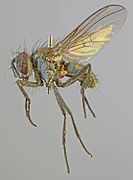Coenosia agromyzina
Appearance
| Coenosia agromyzina | |
|---|---|

| |
| Scientific classification | |
| Domain: | Eukaryota |
| Kingdom: | Animalia |
| Phylum: | Arthropoda |
| Class: | Insecta |
| Order: | Diptera |
| Family: | Muscidae |
| Genus: | Coenosia |
| Species: | C. agromyzina
|
| Binomial name | |
| Coenosia agromyzina (Fallen, 1825)
| |
| Synonyms | |
| |
Coenosia agromyzina is a species of fly in the family Muscidae.[1][2]
Distribution
This common species can be found in the Palearctic realm .[3] [4]
Description
Coenosia agromyzina can reach a length of 2–3.5 millimetres (0.079–0.138 in).[5] The thorax and abdomen show a brownish-black coloration. The antennae are black and rather elongated. Also palps are black. The legs are black. The wings are slightly brown-gray tinted. The main vein running along the leading edge of the wings ends at the cubital vein.[4][5]
Biology
Adults fly from May to October preying on small chironomids, honeydew and Hedera flowers. Larvae of these flies can be found in March feeding on tiny earthworms (Oligochaeta).[6][7]
-
Mounted specimen
References
Wikispecies has information related to Coenosia agromyzina.
Wikimedia Commons has media related to Coenosia agromyzina.
- ^ BioLib
- ^ Catalogue of Life
- ^ Fauna Europaea
- ^ a b Bei-Bienko, G.Y. & Steyskal, G.C. (1988) Keys to the Insects of the European Part of the USSR, Volume V: Diptera and Siphonaptera, Parts I, II. Amerind Publishing Co., New Delhi. ISBN 81-205-0080-6 ISBN 81-205-0081-4
- ^ a b Insekten Box
- ^ Lloyd Vernon Knutson, Jean-Claude Vala Biology of Snail-Killing Sciomyzidae Flies
- ^ Peter Skidmore The Biology of the Muscidae of the World

